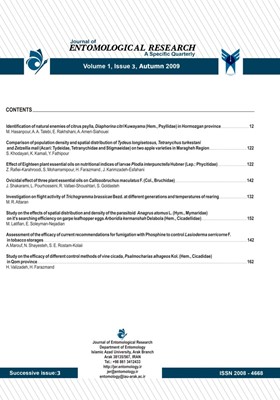Comparison of population density and spatial distribution of Tydeus longisetosus El-Bagoury & Momen, Tetranychus turkestani (Ugarov & Nikolskii) and their predator Zetzellia mali (Ewing) on two apple varieties
Subject Areas : entomology and othea arthropodsS. Khodayari 1 , K. Kamali 2 , Y. Fathipour 3
1 - Entomology Department, Agricultural Faculty,Tarbait Modarres University, Tehran, Iran
2 - Entomology Department, Agricultural Faculty,Tarbait Modarres University, Tehran, Iran
3 - Entomology Department, Agricultural Faculty,Tarbait Modarres University, Tehran, Iran
Keywords:
Abstract :
Population density of Tydeus longisetosus El-Bagoury & Momen, Tetranychus turkestani (Ugarov & Nikolskii) and their predator Zetzellia mali (Ewing) on two varieties of apple (Golden delicious and Golab) was studied in Maragheh (Northwestern of Iran) during summer of 2006. The result showed that the mean density of T. longisetosus and T. turkestani on Golden delicious and Golab varieties were 3.35±0.67, 4.02±0.91 and 1.022±0.12, 1.26±0.45 per leaf, respectively. The mean density of Z. mali were 0.829±0.23 and 1.057±0.25 per leaf on Golden delicious and Golab varieties, respectively. Comparison of mean densities on two varieties was done by t-test and showed no significant differences between mean densities on two varieties. Spatial distribution of two species was determined by Taylor's power law, Morisita's coefficient and index of dispersion. Taylor's power law showed that spatial distribution of T. longisetosus on Golden delicious and Golab varieties wasaggregated and random, respectively. T. turkestani was distributed in aggregated pattern on Golab variety and there was no significant relationship between its parameters on Golden delicious, in this way Z. mali was distributed randomly on two varieties too. Aggregated spatial distribution of all species was determined by Morisita's coefficient and index of dispersion on two varieties in most cases. Linear regression between mean density of phytophagous and predaceous mites showed that the predator acts as density independent. Apple varieties have no effect on population density of studied mites but make an effect on spatial distribution of them to some extents.


